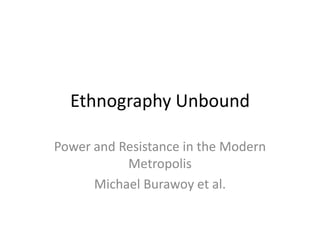Michael burawoy
•
1 j'aime•3,736 vues
Alternatives to Grounded Theory
Signaler
Partager
Signaler
Partager

Recommandé
Recommandé
Contenu connexe
Similaire à Michael burawoy
Similaire à Michael burawoy (20)
A reflection on modeling and the nature of knowledge

A reflection on modeling and the nature of knowledge
Afro centric methodology and proper research design

Afro centric methodology and proper research design
Fue theory 4 lecture 3 - theory in relation to method

Fue theory 4 lecture 3 - theory in relation to method
Plus de D.L. Bearden, PhD
Plus de D.L. Bearden, PhD (20)
Dernier
God is a creative God Gen 1:1. All that He created was “good”, could also be translated “beautiful”. God created man in His own image Gen 1:27. Maths helps us discover the beauty that God has created in His world and, in turn, create beautiful designs to serve and enrich the lives of others.
Explore beautiful and ugly buildings. Mathematics helps us create beautiful d...

Explore beautiful and ugly buildings. Mathematics helps us create beautiful d...christianmathematics
This presentation was provided by William Mattingly of the Smithsonian Institution, during the fourth segment of the NISO training series "AI & Prompt Design." Session Four: Structured Data and Assistants, was held on April 25, 2024.Mattingly "AI & Prompt Design: Structured Data, Assistants, & RAG"

Mattingly "AI & Prompt Design: Structured Data, Assistants, & RAG"National Information Standards Organization (NISO)
Dernier (20)
Web & Social Media Analytics Previous Year Question Paper.pdf

Web & Social Media Analytics Previous Year Question Paper.pdf
Explore beautiful and ugly buildings. Mathematics helps us create beautiful d...

Explore beautiful and ugly buildings. Mathematics helps us create beautiful d...
SECOND SEMESTER TOPIC COVERAGE SY 2023-2024 Trends, Networks, and Critical Th...

SECOND SEMESTER TOPIC COVERAGE SY 2023-2024 Trends, Networks, and Critical Th...
Mattingly "AI & Prompt Design: Structured Data, Assistants, & RAG"

Mattingly "AI & Prompt Design: Structured Data, Assistants, & RAG"
Seal of Good Local Governance (SGLG) 2024Final.pptx

Seal of Good Local Governance (SGLG) 2024Final.pptx
Unit-IV; Professional Sales Representative (PSR).pptx

Unit-IV; Professional Sales Representative (PSR).pptx
Beyond the EU: DORA and NIS 2 Directive's Global Impact

Beyond the EU: DORA and NIS 2 Directive's Global Impact
Michael burawoy
- 1. Ethnography Unbound Power and Resistance in the Modern Metropolis Michael Burawoy et al.
- 2. “In the face of commodification through money and administration through power, everyday life loses it autonomy and shared purpose.” Page 2
- 3. Glaser and Strauss “In short, our focus on the emergence of categories solves problems of fit, relevance, forcing, and richness. An effective strategy is, at first, literally to ignore the literature of theory and fact on the area under study, in order to assure that the emergence of categories will not be contaminated by concepts more suited to different areas.” quoted in Burawoy et al. page 10
- 4. Grounded theory • Glaser and Strauss approach social phenomena from the standpoint of their generality • Each case study is a potential exemplar of some general law or principle • Move from substantive theory to formal theory • Theory emerges from the field
- 5. Grounded theory • Glaser and Strauss are concerned to develop – Concepts – Categories – Dimensions – Sampling • Grounded in the data • Reflecting the data’s complexity and richness
- 6. Extended Case Method • Trys to include more phenomena under a single covering law • Elaborates the effects of the macro on the micro • Specifies some particular feature of the social situation that requires reference to external forces • Looks for the unexpected • Treats social phenomena as counter instances of some old theory
- 7. Extended Case Method • Instead of an exemplar the social situation is viewed as an anomaly • Lays out what is expected in the study site before entry • Discovers the unexpected and then turns to existing bodies of theory that might shed light on the anomaly. • The shortcomings of theory become grounds for reconstruction • What is interesting in the field emerges from our theory
- 8. Karl Popper • Verification & Induction are flawed strategies and lead to infinite regress – No matter how many white swans we find it does not prove that all swans are white • It is better to proceed by – Conjecture and refutation – Falsification – if we look for not white swans in places they are likely to be (if they exist) and fail to find them then we reject the theory that not white swans exist. It does not prove that all swans are white but it builds confidence in the theory
- 9. Extended Case Method • Do not forsake a theory because it faces falsification – improve theories by turning anomalies into exemplars • Counterinstances are seized upon to reconstruct our theories • Other kinds of theoretical failure – Internal contradictions (Gouldner’s study of bureaucracy) – Theoretical gaps or silences • Reconstruct theory by a running exchange between field notes and analysis • The conjectures of yesterday’s analysis are refuted by today’s observations and then reconstructed in tomorrow’s analysis
